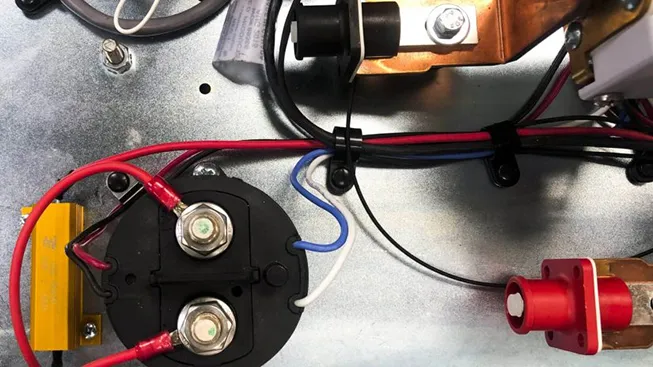August 19, 2019
Battery Management for Large-Scale Energy Storage (Part 1)
Part 1 of 4:
- Battery Management and Large-Scale Energy Storage
- Battery Monitoring vs. Battery Management
- Communication Between the BMS and the PCS
Battery Management and Large-Scale Energy Storage
While all battery management systems (BMS) share certain roles and responsibilities in an energy storage system (ESS), they do not all include the same features and functions that a BMS can contribute to the operation of an ESS. This article will explore the general roles and responsibilities of all battery management systems, and will also reference Nuvation Energy’s battery management system when exploring specific functions and features that may or may not be included in all battery management systems but which are important to the management of any energy storage system.
This article is a primer for energy storage industry professionals who would like to gain a better understanding of battery management in large-scale applications. After reading it you will be able to hold your own in most conversations about battery management, whether you are chatting with energy storage colleagues at a conference, or taking part in a planning meeting about the design and build of your next energy storage system. It will not answer all your questions, but we hope it empowers you to ask new questions that advance the long-term viability of your energy storage system.
Multiple devices coordinate with each other in an energy storage system to operate the batteries within their nominal operating parameters. The management of these parameters:
- Enables the battery to perform the tasks required by the energy storage application.
- Protects the battery from becoming damaged during use.
- Ensures system safety.
Topics we will cover include:
- The role of the BMS in the energy storage system
- Communicating with energy controllers
- Cell balancing
- State of Charge (SoC) and Depth of Discharge (DoD)
- Warnings, Faults, and User-Defined Thresholds
- Battery Management for Lead-Acid Batteries
This article is generally applicable to most battery chemistries, including lithium-ion, lead-acid, zinc-based, nickel-based etc., and will specify when a discussion point applies to only a subset of battery chemistries.
Battery Monitoring vs. Battery Management
Battery management systems and battery monitoring systems both use sensors connected to cells in a battery module to collect temperature, voltage, and current data. They also apply algorithms to this data to determine how much energy is available for use in the battery at any given time, and can share this data with other ESS control systems including safety systems, energy management systems, and energy storage applications. These consumers of battery data use this information to perform their tasks and to ensure that their operation does not result in safety issues or damage to the batteries.
In this article we’ll use the term “BMS” to refer only to battery management systems. The key difference between battery monitoring and battery management is that while both systems can provide data to other ESS components, a battery monitoring system is a passive data collection device whereas a battery management system takes direct action to protect the battery. For example, a battery management system will disconnect the battery to prevent a safety-related situation from escalating, and performs cell balancing (we’ll talk more about balancing later) during the charge cycle.
At the battery stack level, when integrated into a Stack Switchgear device, Nuvation Energy’s BMS makes decisions about when it is safe to connect a battery stack to the rest of the energy storage system, and can automatically perform that connection. At Nuvation Energy the term ‘Stack Switchgear’ refers to our battery stack control system. It includes battery management modules, fuses, bus bars, contactors, current shunts, networking hardware and other components that work together to manage the cells, connect and disconnect a battery stack to and from the DC bus, and communicate with other ESS control systems.
With a few exceptions, most battery chemistries require a BMS to support their day to day operation. All batteries can become damaged when abused, and a BMS helps prevent such damage. The term ‘abuse’ refers to the operation of the batteries outside of their nominal parameters. While ‘damage’ can take many forms, the most common type is to the active material in the cell, which results in the battery having less power capability, and retaining less energy (i.e. having a lower capacity) at a full charge.
Battery monitoring systems rarely provide as much algorithm-derived data as battery management systems. For example, one Nuvation Energy island grid (i.e. the utility grid of a small tropical island) client replaced a lead-acid battery manufacturer’s monitoring system with Nuvation’s battery management system because the monitoring system derived SoC using only stack voltage sensor data. This is not a very accurate way to derive the SoC of a battery while current is flowing through it, because the battery voltage changes with varying current. This ESS was utilizing large-format 2.2 Volt lead-acid cells, which were very expensive due to their large size. The system was being deployed in a remote location where the shipping of replacement batteries (or anything else) was quite challenging. So this system needed to work as reliably as possible, for as long as possible, and incur as few service calls as possible. Nuvation’s BMS was the preferred option for ensuring reliable SoC data because it derives SoC using a combination of per-cell and overall stack voltage data in addition to coulomb counting. Also, the stack-level SoC data it communicates to the PCS includes information that enables the PCS to respond to individual cells at risk.
Communication Between the BMS and PCS
A key device with which the BMS shares data is the power conversion system (PCS). The primary task of the PCS is to manage the charging and discharging of the battery. The PCS uses BMS data to regulate current within the battery cells and ensure that its operation does not damage the batteries. Other ways the PCS leverages battery data from the BMS include:
- When the BMS disconnects a battery stack in response to a battery fault (e.g. overvoltage, over-discharge), Nuvation Energy’s will communicate the reduction in total ESS capacity to the PCS. Alternately, when Nuvation Energy’s Stack Switchgear connects a battery stack to the DC bus, the BMS will communicate the capacity increase to the PCS. This data sharing allows the smart PCS and higher-level energy controllers to factor into their decision-making the amount of energy that is available in the ESS at any given time battery management systemt system will communicate the reduction in total ESS capacity to the PCS. Alternately, when Nuvation Energy’s Stack Switchgear connects a battery stack to the DC bus, the BMS will communicate the capacity increase to the PCS. This data sharing allows the smart PCS and higher-level energy controllers to factor into their decision-making the amount of energy that is available in the ESS at any given time.
- The PCS obtains current limit thresholds from the BMS. Nuvation’s battery management system lowers the current limits as cell temperatures and voltages approach their rated thresholds. As long as the PCS is adjusting current based on data obtained from the BMS, it will avoid causing battery voltage and temperature overages that would occur from the application of excessive current.

The PCS receives aggregated battery data from the BMS, which it uses to ensure that it is managing the energy flowing in and out of the battery in a manner that does not result in battery damage or safety issues. The way that data is aggregated is critical to the prevention of battery damage. If for example, the BMS shared only the “average” of all cell temperatures and voltages, then that data would obscure individual cell temperatures and voltages that are exceeding their nominal thresholds. The PCS might then take no action to mitigate risk to the battery, because it was not informed by the BMS that such a risk was present. However, power conversion systems are not designed to receive individual cell-level data from the BMS. The BMS must therefore provide aggregate battery performance data that also identifies cell-level risk to the battery. Nuvation Energy’s BMS achieves this by continually running a series of complex algorithms that generates an aggregate data set which includes information that enables the PCS to recognize the presence of cell-level risks and take actions to mitigate them.
The quality of these very sophisticated algorithms directly impacts how well or poorly the battery management system performs this sensor data processing task. When BMS-derived data is incorrect, batteries can become damaged due to the erroneous reporting of safe-state conditions to the PCS. Alternately, flawed BMS algorithms can erroneously report the existence of a risk condition, which can result in the disconnection of a battery system for safety reasons when such a condition is not actually present.
Up Next
- Open Wire Detection
- Energizing and De-Energizing the Contactors
- Thermal Runaway Mitigation

